
Concept explainers
(a)
Interpretation:
The polarity of the given molecule is to be determined.
Concept introduction:
The dipole moment of a molecule is a measure of the magnitude of its dipole. A dipole moment is a vector, which has both magnitude and direction. Bond polarity originates from bonds between atoms of different electronegativity. Symmetry of molecules also predicts the polarity of a molecule.
Answer to Problem 2.41P
The given molecule A is nonpolar.
Explanation of Solution
![]()
The given molecule is in trans form. The directions of the vectors of both the C-F bonds are equal but opposite to each other. Hence the dipole moments of both the C-F bonds get cancelled out with each other. Therefore, there is no net dipole moment.
Dipole moment on this molecule is symmetrically distributed; hence the given molecule A is nonpolar.
(b)
Interpretation:
The polarity of the given molecule is to be determined.
Concept introduction:
The dipole moment of a molecule is a measure of the magnitude of its dipole. A dipole moment is a vector, which has both magnitude and direction. Bond polarity originates from bonds between atoms of different electronegativity. Symmetry of molecules also predicts the polarity of a molecule.
Answer to Problem 2.41P
The given molecule B is polar.
Explanation of Solution

The given molecule is in cis form. The direction of vectors of both the C-F bonds is in the same direction, giving a net permanent dipole moment to the molecule.
Dipole moment on this molecule is not symmetrically distributed; hence the given molecule B is polar.
(c)
Interpretation:
The polarity of the given molecules is to be determined.
Concept introduction:
The dipole moment of a molecule is a measure of the magnitude of its dipole. A dipole moment is a vector, which has both magnitude and direction. Bond polarity originates from bonds between atoms of different electronegativity. Symmetry of molecules also predicts the polarity of a molecule.
Answer to Problem 2.41P
Molecule C is nonpolar.
Explanation of Solution
![]()
In this molecule, both the C-Cl bonds are opposite to each other, so the dipole moments are cancelled out with each other. Therefore, there is no net dipole moment in this molecule.
Dipole moment on this molecule is symmetrically distributed; hence the given molecule C is nonpolar.
(d)
Interpretation:
The polarity of the given molecules is to be determined.
Concept introduction:
The dipole moment of a molecule is a measure of the magnitude of its dipole. A dipole moment is a vector, which has both magnitude and direction. Bond polarity originates from bonds between atoms of different electronegativity. Symmetry of molecules also predicts the polarity of a.
Answer to Problem 2.41P
The given molecule D is polar.
Explanation of Solution
![]()
In this molecule, chlorine is more electronegative than the carbon atom; hence the direction of the vector of dipole moment is more towards C-Cl bond, giving a net dipole moment to the molecule.
Dipole moment on this molecule is not symmetrically distributed; hence the given molecule D is polar.
(e)
Interpretation:
The polarity of the given molecules is to be determined.
Concept introduction:
The dipole moment of a molecule is a measure of the magnitude of its dipole. A dipole moment is a vector, which has both magnitude and direction. Bond polarity originates from bonds between atoms of different electronegativity. Symmetry of molecules also predicts the polarity of a molecule.
Answer to Problem 2.41P
Molecule E is polar.
Explanation of Solution
![]()
In this molecule, Chlorine is more electronegative than bromine; hence the direction of the vector of dipole moment is more towards C-Cl bond, giving a net dipole moment to the molecule.
Dipole moment on this molecule is not symmetrically distributed; hence the given molecule E is polar.
(f)
Interpretation:
The polarity of the given molecules is to be determined.
Concept introduction:
The dipole moment of a molecule is a measure of the magnitude of its dipole. A dipole moment is a vector, which has both magnitude and direction. Bond polarity originates from bonds between atoms of different electronegativity. Symmetry of molecules also predicts the polarity of a molecule.
Answer to Problem 2.41P
Molecule F is nonpolar.
Explanation of Solution

In this molecule, there is no electronegative atom present since no charge separation is taking place. So there is no net dipole moment.
Dipole moment on this molecule is symmetrically distributed; hence the given molecule F is nonpolar.
(g)
Interpretation:
The polarity of the given molecules is to be determined.
Concept introduction:
The dipole moment of a molecule is a measure of the magnitude of its dipole. A dipole moment is a vector, which has both magnitude and direction. Bond polarity originates from bonds between atoms of different electronegativity. Symmetry of molecules also predicts the polarity of a molecule.
Answer to Problem 2.41P
Molecule G is polar.
Explanation of Solution
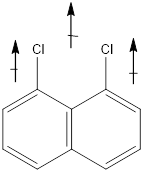
In this molecule, Chlorine is an electronegative atom, and both the C-Cl bonds are in the same direction. Therefore, the direction of the vector of dipole is moment is upward, giving a net dipole moment to the molecule.
Dipole moment on this molecule is not symmetrically distributed; hence the given molecule G is polar.
(h)
Interpretation:
The polarity of the given molecules is to be determined.
Concept introduction:
The dipole moment of a molecule is a measure of the magnitude of its dipole. A dipole moment is a vector, which has both magnitude and direction. Bond polarity originates from bonds between atoms of different electronegativity. Symmetry of molecules also predicts the polarity of a molecule.
Answer to Problem 2.41P
Molecule H is nonpolar.
Explanation of Solution
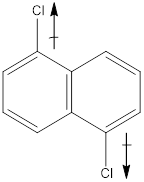
In the molecule, chlorine is an electronegative atom, and both the C-Cl bonds are in opposite direction. Therefore, the directions of the vectors of dipole moment of two C-Cl bonds get cancelled out with each other. Hence there is no net dipole moment.
Dipole moment on this molecule is symmetrically distributed; hence the given molecule H is nonpolar.
(i)
Interpretation:
The polarity of the given molecules is to be determined.
Concept introduction:
The dipole moment of a molecule is a measure of the magnitude of its dipole. A dipole moment is a vector, which has both magnitude and direction. Bond polarity originates from bonds between atoms of different electronegativity. Symmetry of molecules also predicts the polarity of a molecule.
Answer to Problem 2.41P
Molecule I is polar.
Explanation of Solution
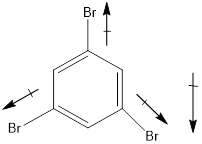
In this molecule, bromine is an electronegative atom, but one C-Br bond is in upward direction, and two C-Br bonds are in downward direction. Therefore, the net dipole moment acts in downward direction.
Dipole moment on this molecule is not symmetrically distributed; hence the given molecule I is polar.
(j)
Interpretation:
The polarity of the given molecules is to be determined.
Concept introduction:
The dipole moment of a molecule is a measure of the magnitude of its dipole. A dipole moment is a vector, which has both magnitude and direction. Bond polarity originates from bonds between atoms of different electronegativity. Symmetry of molecules also predicts the polarity of a molecule.
Answer to Problem 2.41P
Molecule J is polar.
Explanation of Solution
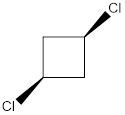
In this molecule, both the C-Cl bonds are present above the plane (that is wedge notation). Therefore, the directions of the vectors of dipole moment of both the C-Cl bonds are in the same direction, giving net dipole moment to the molecule.
Dipole moment on this molecule is not symmetrically distributed; hence the given molecule J is polar.
(k)
Interpretation:
The polarity of the given molecules is to be determined.
Concept introduction:
The dipole moment of a molecule is a measure of the magnitude of its dipole. A dipole moment is a vector, which has both magnitude and direction. Bond polarity originates from bonds between atoms of different electronegativity. Symmetry of molecules also predicts the polarity of a molecule.
Answer to Problem 2.41P
Molecule K is polar.
Explanation of Solution
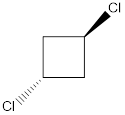
In this molecule, one C-Cl bond is present above the plane (that is, the wedge notation), and another C-Cl bond is present below the plane (that is, the dotted notation). Therefore, the directions of the vectors of dipole moment of both the C-Cl bonds are in opposite direction, which get cancelled out with each other, giving no net dipole moment to the molecule.
Dipole moment on this molecule is symmetrically distributed; hence the given molecule K is nonpolar.
(l)
Interpretation:
The polarity of the given molecules is to be determined.
Concept introduction:
The dipole moment of a molecule is a measure of the magnitude of its dipole. A dipole moment is a vector, which has both magnitude and direction. Bond polarity originates from bonds between atoms of different electronegativity. Symmetry of molecules also predicts the polarity of a molecule.
Answer to Problem 2.41P
Molecule L is polar.
Explanation of Solution

In this molecule, though both the C-Cl bonds are in opposite direction, both the chlorines are present on carbon
Dipole moment on this molecule is not symmetrically distributed; hence the given molecule L is polar.
(m)
Interpretation:
The polarity of the given molecules is to be determined.
Concept introduction:
The dipole moment of a molecule is a measure of the magnitude of its dipole. A dipole moment is a vector, which has both magnitude and direction. Bond polarity originates from bonds between atoms of different electronegativity. Symmetry of molecules also predicts the polarity of a molecule.
Answer to Problem 2.41P
Molecule M is nonpolar.
Explanation of Solution
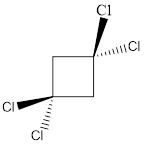
In this molecule, two C-Cl bonds are above the plane, and two C-Cl bonds are below the plane; hence the molecule has symmetry. The directions of the vectors of dipole moment of all the four C-Cl bonds are cancelled with each other, giving no net dipole moment to the molecule.
Dipole moment on this molecule is symmetrically distributed; hence the given molecule M is nonpolar.
(n)
Interpretation:
The polarity of the given molecules is to be determined.
Concept introduction:
The dipole moment of a molecule is a measure of the magnitude of its dipole. A dipole moment is a vector, which has both magnitude and direction. Bond polarity originates from bonds between atoms of different electronegativity. Symmetry of molecules also predicts the polarity of a molecule.
Answer to Problem 2.41P
Molecule N is polar.
Explanation of Solution
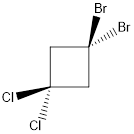
In this molecule, two C-Cl and two C-Br bonds are present. Since chlorine is more electronegative than bromine, the direction of the vector of dipole moment is towards C-Cl bonds. Therefore, there is a net dipole moment present in this molecule.
Dipole moment on this molecule is not symmetrically distributed; hence the given molecule N is polar.
Want to see more full solutions like this?
Chapter 2 Solutions
ORG CHEM W/ EBOOK & SW5 + STUDY GUIDE
- Please help me figure out what the slope is and how to calculate the half life Using the data provided.arrow_forwardCurved arrows are used to illustrate the flow of electrons. Follow the curved arrows and draw the structure of the missing reactants, intermediates, or products in the following mechanism. Include all lone pairs. Ignore stereochemistry. Ignore inorganic byproducts. H Br2 (1 equiv) H- Select to Draw Starting Alkene Draw Major Product I I H2O 四: ⑦.. Q Draw Major Charged Intermediate Iarrow_forwardNH (aq)+CNO (aq) → CO(NH2)2(s) Experiment [NH4] (M) [CNO] (M) Initial rate (M/s) 1 0.014 0.02 0.002 23 0.028 0.02 0.008 0.014 0.01 0.001 Calculate the rate contant for this reaction using the data provided in the table.arrow_forward
- 2CIO2 + 20H-1 CIO31 + CIO2 + H2O Experiment [CIO2], M [OH-1], M 1 0.0500 0.100 23 2 0.100 0.100 3 0.100 0.0500 Initial Rate, M/s 0.0575 0.230 0.115 ... Given this date, calculate the overall order of this reaction.arrow_forward2 3 .(be)_[Ɔ+(be)_OI ← (b²)_IƆO+ (be)_I Experiment [1-] M 0.005 [OCI-] 0.005 Initial Rate M/min 0.000275 0.0025 0.005 0.000138 0.0025 0.0025 0.000069 4 0.0025 0.0025 0.000140 Calculate the rate constant of this reaction using the table data.arrow_forward1 2 3 4 I(aq) +OCl(aq) → IO¯¯(aq) + Cl¯(aq) Experiment [I-] M 0.005 [OCI-] 0.005 Initial Rate M/min 0.000275 0.0025 0.005 0.000138 0.0025 0.0025 Calculate the overall order of this reaction using the table data. 0.0025 0.000069 0.0025 0.000140arrow_forward
- H2O2(aq) +3 I¯(aq) +2 H+(aq) → 13(aq) +2 H₂O(l)· ••• Experiment [H2 O2]o (M) [I]o (M) [H+]。 (M) Initial rate (M/s) 1 0.15 0.15 0.05 0.00012 234 0.15 0.3 0.05 0.00024 0.3 0.15 0.05 0.00024 0.15 0.15 0.1 0.00048 Calculate the overall order of this reaction using the table data.arrow_forwardThe U. S. Environmental Protection Agency (EPA) sets limits on healthful levels of air pollutants. The maximum level that the EPA considers safe for lead air pollution is 1.5 μg/m³ Part A If your lungs were filled with air containing this level of lead, how many lead atoms would be in your lungs? (Assume a total lung volume of 5.40 L.) ΜΕ ΑΣΦ = 2.35 1013 ? atoms ! Check your rounding. Your final answer should be rounded to 2 significant figures in the last step. No credit lost. Try again.arrow_forwardY= - 0.039 (14.01) + 0.7949arrow_forward
- Suppose 1.76 g of magnesium acetate (Mg (CH3CO2)2) are dissolved in 140. mL of water. Find the composition of the resulting electrolyte solution. In particular, list the chemical symbols (including any charge) of each dissolved ion in the table below. List only one ion per row. mEq Then, calculate the concentration of each ion in dwrite the concentration in the second column of each row. Be sure you round your answers to the L correct number of significant digits. ion Add Row mEq L x 5arrow_forwardA pdf file of your hand drawn, stepwise mechanisms for the reactions. For each reaction in the assignment, you must write each mechanism three times (there are 10 reactions, so 30 mechanisms). (A) do the work on a tablet and save as a pdf., it is expected to write each mechanism out and NOT copy and paste the mechanism after writing it just once. Everything should be drawn out stepwise and every bond that is formed and broken in the process of the reaction, and is expected to see all relevant lone pair electrons and curved arrows.arrow_forwardNonearrow_forward
 Organic Chemistry: A Guided InquiryChemistryISBN:9780618974122Author:Andrei StraumanisPublisher:Cengage Learning
Organic Chemistry: A Guided InquiryChemistryISBN:9780618974122Author:Andrei StraumanisPublisher:Cengage Learning Chemistry: Matter and ChangeChemistryISBN:9780078746376Author:Dinah Zike, Laurel Dingrando, Nicholas Hainen, Cheryl WistromPublisher:Glencoe/McGraw-Hill School Pub Co
Chemistry: Matter and ChangeChemistryISBN:9780078746376Author:Dinah Zike, Laurel Dingrando, Nicholas Hainen, Cheryl WistromPublisher:Glencoe/McGraw-Hill School Pub Co Introductory Chemistry: An Active Learning Approa...ChemistryISBN:9781305079250Author:Mark S. Cracolice, Ed PetersPublisher:Cengage Learning
Introductory Chemistry: An Active Learning Approa...ChemistryISBN:9781305079250Author:Mark S. Cracolice, Ed PetersPublisher:Cengage Learning



